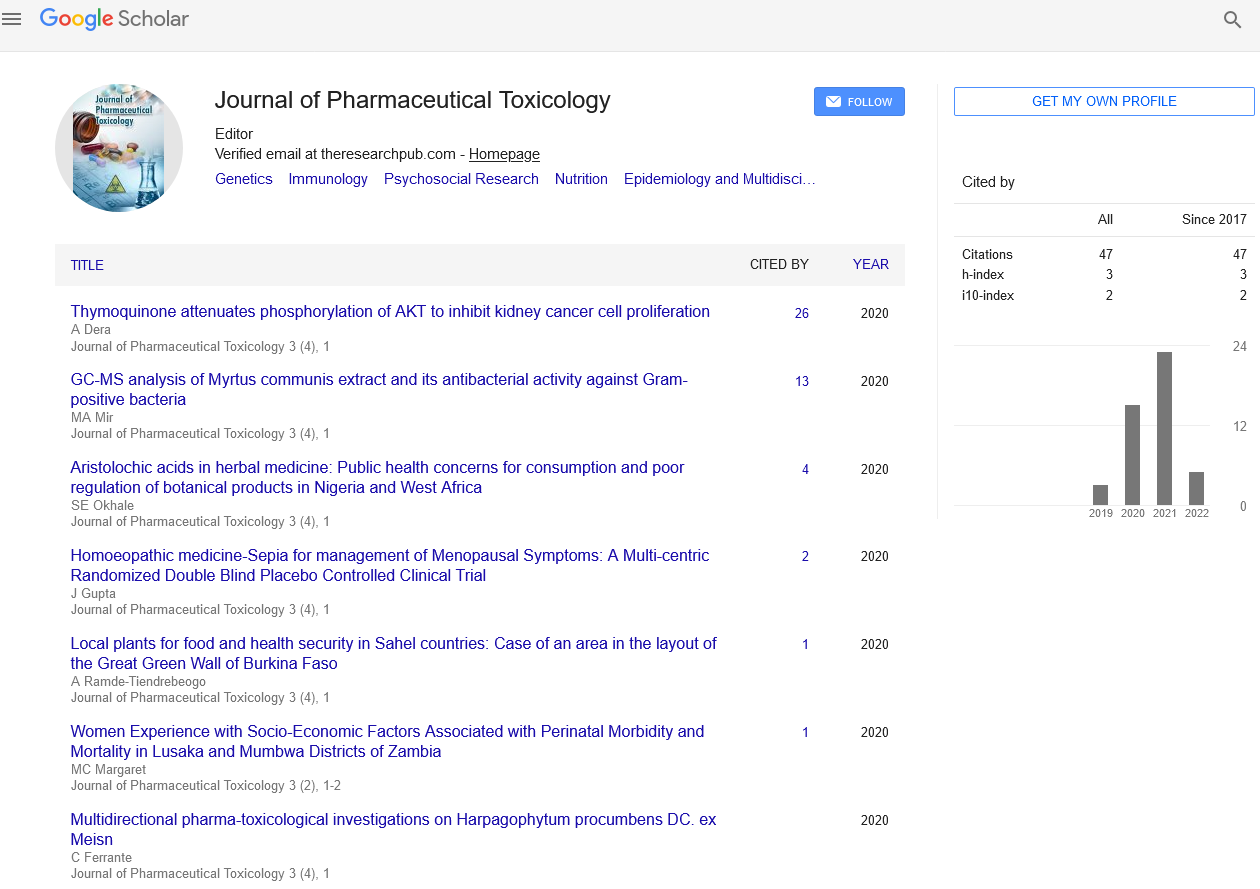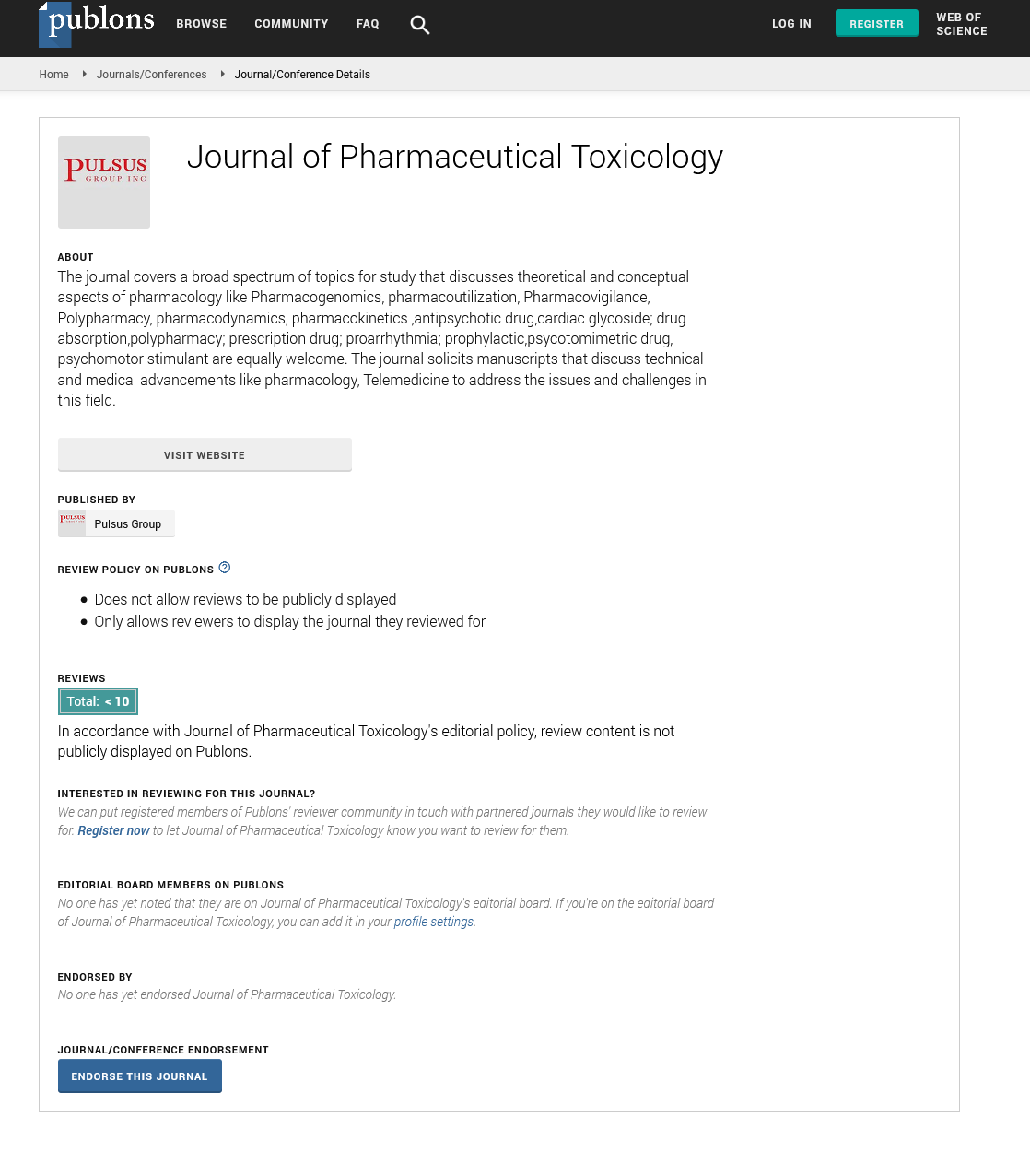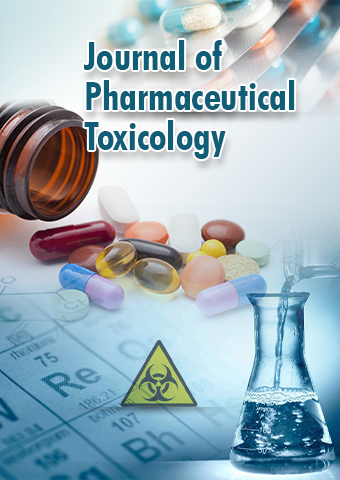Mini Review - Journal of Pharmaceutical Toxicology (2023) Volume 6, Issue 2
Toxicity Testing: Methods and Approaches
Raghav Tadagavadi*
Department of Medicine, Penn State University College of Medicine, USA
Department of Medicine, Penn State University College of Medicine, USA
E-mail: Raghu_t221@gmail.com
Received: 03-April-2023, Manuscript No. jpt-23-96220; Editor assigned: 06-April-2023, PreQC No. jpt-23- 96220 (PQ); Reviewed: 20-April-2023, QC No. jpt-23-96220; Revised: 21-April-2023, Manuscript No. jpt-23- 96220 (R); Published: 28-April-2023 DOI: 10.37532/jpt.2023.6(2).51-53
Abstract
Toxicology is the scientific study of poisons and their effects on living organisms. It encompasses a broad range of topics, from the effects of drugs and chemicals on human health to the impact of environmental toxins on wildlife populations. The field of toxicology is crucial in understanding how toxic substances affect the body and how exposure to these substances can be prevented. The science of toxicology has been around for centuries. In ancient times, people were aware of the toxic properties of certain plants and animals and used this knowledge to create poisons for hunting and warfare. In modern times, toxicology has evolved into a sophisticated science that relies on advanced analytical techniques and a deep understanding of the mechanisms by which toxic substances affect the body.
Keywords
Toxicology • Environmental hazards • Drug administration
Introduction
Toxicology plays an important role in many different fields, including medicine, environmental science, and public health. In medicine, toxicologists work to develop new drugs and therapies, as well as to identify and treat cases of poisoning. In environmental science, toxicologists study the effects of pollutants and other toxins on ecosystems and human health. In public health, toxicologists work to identify and prevent exposure to toxic substances, such as lead, pesticides, and other environmental contaminants. One of the challenges of toxicology is that different individuals may react differently to the same toxin, depending on factors such as age, gender, genetics, and overall health. Toxicologists must take these individual differences into account when evaluating the risks associated with exposure to various substances. They also work to identify safer alternatives to toxic substances, and to develop effective treatments for poisoning [1,2].
Overall, toxicology plays a critical role in protecting human and environmental health. By understanding the science of poisons, toxicologists can help to prevent and treat exposure to harmful substances, and to ensure the safety of the products and chemicals we use every day. Toxicology is the scientific study of poisons and their effects on living organisms. It is a crucial discipline in understanding the potential hazards posed by substances in our environment and developing strategies to mitigate their harmful effects. Toxicologists investigate the properties of toxic substances, the mechanisms by which they cause harm, and the factors that influence their toxicity. Toxicology has a long and fascinating history. Poisoning has been a common method of murder and suicide throughout human history, and early civilizations recognized the potential dangers of certain substances. For example, ancient Greeks knew that hemlock was poisonous and used it as a method of execution. In the middle Ages, toxicology was practiced as a form of forensic science, as physicians tried to determine the cause of sudden deaths [3].
Today, toxicology has many applications, from environmental monitoring and workplace safety to drug development and regulation. Toxicologists use a wide range of tools and techniques to study the effects of toxins, including animal testing, cell culture studies, and computer simulations. They also collaborate with other scientists, including chemists, biologists, and epidemiologists, to gain a comprehensive understanding of how toxic substances interact with living organisms. One of the key concepts in toxicology is dose-response relationship, which describes how the severity of a toxic effect increases with the dose of a substance. This relationship is not always linear; some substances may have a threshold dose below which no effect is observed, while others may have a steep dose-response curve with a small increase in dose leading to a significant increase in toxicity [4,5].
Discussion
Toxicologists also consider the route of exposure when assessing the toxicity of a substance. For example, inhalation of toxic gases or particles can cause respiratory distress, while ingestion of a toxic substance can cause damage to the digestive system. Skin contact with certain substances can also lead to toxicity. Finally, toxicologists study the factors that can modify toxicity. These include genetic factors, age, sex, and pre-existing medical conditions. For example, some individuals may be more susceptible to the toxic effects of a substance due to a genetic variation that affects how the substance is metabolized in the body.
In conclusion, toxicology is a vital field of study that helps us to understand the potential hazards posed by substances in our environment and to develop strategies to mitigate their harmful effects. It has a rich history and continues to play an important role in many areas of science and society. Toxicology is the study of the adverse effects of chemicals or physical agents on living organisms. It involves understanding how exposure to these substances affects the body, as well as identifying and managing the associated risks. Toxicology is a critical field of study that has far-reaching implications for public health and safety. Toxicologists study a wide range of substances, including drugs, pesticides, industrial chemicals, and environmental pollutants [6,7]. They investigate the mechanisms by which these substances can harm the body, including how they are absorbed, metabolized, and excreted. They also explore the ways in which different factors, such as age, sex, and genetics, can influence an individual’s response to these substances [8].
One of the key tasks of toxicologists is to determine the safe levels of exposure to these substances. This involves evaluating the dose-response relationship, which describes the relationship between the amount of a substance that is ingested or absorbed and the resulting effect on the body. Toxicologists use this information to set safety standards and guidelines for exposure. Toxicology plays an essential role in the development of new drugs and other chemical products. It is used to evaluate the safety and efficacy of these products before they are approved for use by the general public. Toxicologists also play a crucial role in assessing the safety of products that are already on the market, such as food additives, cosmetics, and household chemicals [9,10].
Conclusion
Environmental toxicology is a subfield of toxicology that focuses on the effects of chemicals and pollutants on the environment. It involves studying the impact of these substances on ecosystems, wildlife, and human populations living in affected areas. Environmental toxicologists play a critical role in identifying and mitigating the risks associated with exposure to these substances. In conclusion, toxicology is a vital field of study that helps us to understand the risks associated with exposure to chemicals and other substances. By evaluating the potential hazards and determining safe levels of exposure, toxicologists play a critical role in protecting public health and safety. The work of toxicologists is essential in the development of new products and technologies, as well as in the ongoing evaluation of existing products and environmental conditions.
Conflict of Interest
None
Acknowledgement
None
References
- Ogurtsova K, Fernandes JD, Huang Y et al. IDF Diabetes Atlas Global estimates for the prevalence of diabetes. Diabetes Res Clin Pract. 128, 40-50 (2017).
- Zhou Z, Mahdi A, Tratsiakovich Y et al. Erythrocytes From Patients With Type 2 Diabetes Induce Endothelial Dysfunction Via Arginase I. J Am Coll Cardiol. 72, 769-780 (2018).
- Sprague RS, Stephenson AH, EA Bowles et al. Reduced expression of Gi in erythrocytes of humans with type 2 diabetes is associated with impairment of both cAMP generation and ATP release. Diabetes. 55, 3588-3593.
- Blaslov K, Kruljac I, Mirošević G et al. The prognostic value of red blood cell characteristics on diabetic retinopathy development and progression in type 2 diabetes mellitus. Clin Hemorheol Microcirc. 71, 475-481 (2019).
- Venerando B, Fiorilli A, Croci G et al. Acidic and neutral sialidase in the erythrocyte membrane of type 2 diabetic patients. Blood. 99, 1064-1070 (2002).
- Kadiyala R, Peter R, Okosieme OE et al. Thyroid dysfunction in patients with diabetes: clinical implications and screening strategies. Int J Clin Pract. 64, 1130-1139 (2010).
- Clark A, Jones LC, de Koning E et al. Decreased insulin secretion in type 2 diabetes: a problem of cellular mass or function. Diabetes. 50, 169-171 (2001).
- DeFronzo RA. Pathogenesis of type 2 diabetes: metabolic and molecular implications for identifying diabetes genes. Diabetes Reviews. 5, 177-269 (1997).
- Peppa M, Betsi G, Dimitriadis G et al. Lipid abnormalities and cardio metabolic risk in patients with overt and subclinical thyroid disease. J Lipids. 9, 575-580 (2011).
- Cettour-Rose P, Theander-Carrillo C, Asensio C et al. Hypothyroidism in rats decreases peripheral glucose utilisation, a defect partially corrected by central leptin infusion. Diabetologia. 48, 624-633 (2005).
Google Scholar, Crossref, Indexed at
Google Scholar, Crossref, Indexed at
Google Scholar, Crossref, Indexed at
Google Scholar, Crossref, Indexed at
Google Scholar, Crossref, Indexed at
Google Scholar, Crossref, Indexed at
Google Scholar, Crossref, Indexed at
Google Scholar, Crossref, Indexed at
Google Scholar, Crossref, Indexed at


